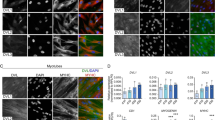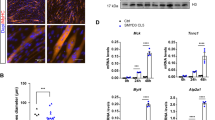Abstract
The high mobility group type A-2 (HMGA2) transcription factor is involved in proliferation and differentiation, mainly during embryogenesis. Its activated form (HMGA2/T) presents oncogenic activities both in vivo and in vitro. However, its precise role during embryogenesis is unknown. We investigated its role during the commitment of mouse embryonic stem (ES) cells by constructing cell lines expressing either wild type (wt) or HMGA2/T forms of the gene. Following differentiation, control and wt HMGA2 ES cells did not display myotubes; whereas HMGA2/T ES cell lines massively formed contractile myotubes. Furthermore, as opposed to control cells, HMGA2/T ES cells highly expressed the muscle myosin heavy chain (MHC) marker. Interestingly, in experimental conditions inhibitory for myogenesis, we observed a strong expression of MyoD and myogenin in HMGA2/T cells. By contrast, commitment into adipocyte, neuron, and cardiomyocyte lineages was not affected. Teratocarcinomas induced by HMGA2/T ES cell lines presented numerous skeletal muscle-differentiated tissues that were not observed in wt HMGA2 or control tumours. Finally, rapamycin, an inhibitor of the mTOR kinase, downregulated endogenous HMGA-2 expression and inhibited myogenesis. This effect was prevented by overexpression of exogenous HMGA-2. Our results reveal a novel function of HMGA-2 in skeletal muscle differentiation.
This is a preview of subscription content, access via your institution
Access options
Subscribe to this journal
Receive 50 print issues and online access
$259.00 per year
only $5.18 per issue
Buy this article
- Purchase on Springer Link
- Instant access to full article PDF
Prices may be subject to local taxes which are calculated during checkout







Similar content being viewed by others
References
Anand A and Chada K . (2000). Nat. Genet., 24, 377–380.
Anisimov SV, Tarasov KV, Riordon D, Wobus AM and Boheler KR . (2002). Mech. Dev., 117, 25–74.
Ashar HR, Fejzo MS, Tkachenko A, Zhou X, Fletcher JA, Weremowicz S, Morton CC and Chada K . (1995). Cell, 82, 57–65.
Baldassarre G, Fedele M, Battista S, Vecchione A, Klein-Szanto AJ, Santoro M, Waldmann TA, Azimi N, Croce CM and Fusco A . (2001). Proc. Natl. Acad. Sci. USA, 98, 7970–7975. Epub Jun 26, 2001.
Battista S, Fidanza V, Fedele M, Klein-Szanto AJ, Outwater E, Brunner H, Santoro M, Croce CM and Fusco A . (1999). Cancer Res., 59, 4793–4797.
Bost F, Caron L, Marchetti I, Dani C, Le Marchand-Brustel Y and Binetruy B . (2002). Biochem. J., 361, 621–627.
Chieffi P, Battista S, Barchi M, Di Agostino S, Pierantoni GM, Fedele M, Chiariotti L, Tramontano D and Fusco A . (2002). Oncogene, 21, 3644–3650.
Colmenares C and Stavnezer E . (1989). Cell, 59, 293–303.
Fedele M, Berlingieri MT, Scala S, Chiariotti L, Viglietto G, Rippel V, Bullerdiek J, Santoro M and Fusco A . (1998). Oncogene, 17, 413–418.
Gao X, Zhang Y, Arrazola P, Hino O, Kobayashi T, Yeung RS, Ru B and Pan D . (2002). Nat. Cell. Biol., 4, 699–704.
Hirning-Folz U, Wilda M, Rippe V, Bullerdiek J and Hameister H . (1998). Genes Chromosomes Cancer, 23, 350–357.
Hunter DS, Klotzbucher M, Kugoh H, Cai SL, Mullen JP, Manfioletti G, Fuhrman U and Walker CL . (2002). Cancer Res., 62, 3766–3772.
Molkentin JD and Olson EN . (1996). Curr. Opin. Genet. Dev., 6, 445–453.
Niwa H, Yamamura K and Miyazaki J . (1991). Gene, 108, 193–199.
Noro B, Licheri B, Sgarra R, Rustighi A, Tessari MA, Chau KY, Ono SJ, Giancotti V and Manfioletti G . (2003). Biochemistry, 42, 4569–4577.
Pende M, Um SH, Mieulet V, Sticker M, Goss VL, Mestan J, Mueller M, Fumagalli S, Kozma SC and Thomas G . (2004). Mol. Cell. Biol., 24, 3112–3124.
Reeves R and Beckerbauer L . (2001). Biochim. Biophys. Acta, 1519, 13–29.
Reeves R and Nissen M . (1999). Methods Enzymol., 304, 155–188.
Tallini G, Vanni R, Manfioletti G, Kazmierczak B, Faa G, Pauwels P, Bullerdiek J, Giancotti V, Van Den Berghe H and Dal Cin P . (2000). Lab. Invest., 80, 359–369.
Vernochet C, Milstone DS, Iehle C, Belmonte N, Phillips B, Wdziekonski B, Villageois P, Amri EZ, O'Donnell PE, Mortensen RM, Ailhaud G and Dani C . (2002). FEBS Lett., 510, 94–98.
Wobus AM . (2001). Mol. Aspects Med., 22, 149–164.
Zhou X, Benson KF, Ashar HR and Chada K . (1995). Nature, 376, 771–774.
Zhou X, Benson KF, Przybysz K, Liu J, Hou Y, Cherath L and Chada K . (1996). Nucleic Acids Res., 24, 4071–4077.
Acknowledgements
We thank Y Le Marchand-Brustel, J Vukmirica and JF Tanti for critical reading of the manuscript and Dr Niwa for the gift of CAG plasmid. This work was supported by Fondation Bettencourt-Schueller, ARC (Grants no. 4525 and 7720) and AFM (Grant no. 9986). LC was supported by fellowships from INSERM/Région Provence Alpes Côte d'Azur and the Ligue Nationale Contre le Cancer.
Author information
Authors and Affiliations
Corresponding author
Rights and permissions
About this article
Cite this article
Caron, L., Bost, F., Prot, M. et al. A new role for the oncogenic high-mobility group A2 transcription factor in myogenesis of embryonic stem cells. Oncogene 24, 6281–6291 (2005). https://doi.org/10.1038/sj.onc.1208781
Received:
Revised:
Accepted:
Published:
Issue Date:
DOI: https://doi.org/10.1038/sj.onc.1208781
Keywords
This article is cited by
-
Die Rolle der HMGA-Proteine („high mobility group AT-hook“) bei Proliferation und Differenzierung mesenchymaler Zellen und Gewebe
Gefässchirurgie (2020)
-
Hmga2 is necessary for Otx2-dependent exit of embryonic stem cells from the pluripotent ground state
BMC Biology (2016)
-
Probing into the Biological Processes Influenced by ESC Factor and Oncoprotein HMGA2 Using iPSCs
Stem Cell Reviews and Reports (2013)
-
The CMV early enhancer/chicken β actin (CAG) promoter can be used to drive transgene expression during the differentiation of murine embryonic stem cells into vascular progenitors
BMC Cell Biology (2008)
-
Identification of genes differentially expressed during prenatal development of skeletal muscle in two pig breeds differing in muscularity
BMC Developmental Biology (2007)



